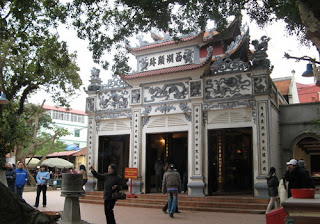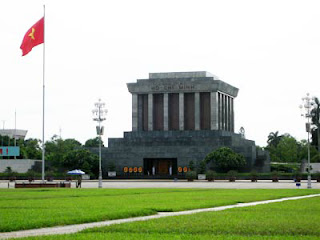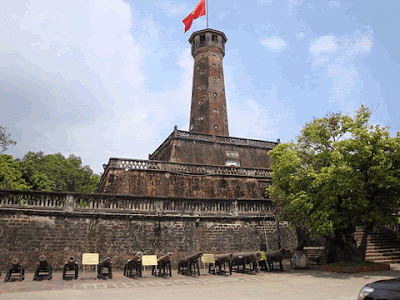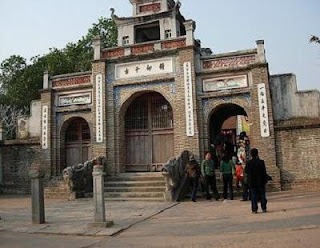With
the fast approach of winter in town, most Hanoi lovers are seeking new
places for snack food and their most iconic wintry dishes are nem chua
ran (fried fermented pork), banh mi thit xien (grilled pork with toast),
or banh chuoi (fried banana cake).
 The
best food shops in Hanoi are tucked away in very small places, or on
really narrow stretches of pavement. It is a common thing to see
formally dressed gentlemen sitting in low chairs for their breakfast
bowl of pho—an interesting Hanoi eating style. But we are not talking
about pho or bun cha, since these great dishes have been introduced to
the world many times over. This beautiful city has a lot more to offer
those who want to eat like a local.
The
best food shops in Hanoi are tucked away in very small places, or on
really narrow stretches of pavement. It is a common thing to see
formally dressed gentlemen sitting in low chairs for their breakfast
bowl of pho—an interesting Hanoi eating style. But we are not talking
about pho or bun cha, since these great dishes have been introduced to
the world many times over. This beautiful city has a lot more to offer
those who want to eat like a local.
Pieces of Nem chua are peeled from their banana leaf wrappings, skewered on bamboo, and grilled over charcoal. Customers
sit on plastic chairs while eating and watch the bustle of the streets.
The spicy, sour, sweet, and peppery flesh tastes especially apt in
winter’s freezing air. This dish is especially popular among teenagers,
who are lucky enough to remain undaunted by its somewhat oily nature.
Two very popular addresses for nem chua ran are along the very narrow
Tạm Thuong (Hang Bong street) and the areas around Nha Chung.
Customers
sit on plastic chairs while eating and watch the bustle of the streets.
The spicy, sour, sweet, and peppery flesh tastes especially apt in
winter’s freezing air. This dish is especially popular among teenagers,
who are lucky enough to remain undaunted by its somewhat oily nature.
Two very popular addresses for nem chua ran are along the very narrow
Tạm Thuong (Hang Bong street) and the areas around Nha Chung.
The second dish on my list of favourites is thit xien nuong. The hot meal is typically authentic Vietnamese fast food, easily found in Quang Trung or Ta Quang Buu Street. If you have a chance to visit the Quang Trung location in the afternoon, you should not be surprised by the crowds enjoying their snack food. Fresh and lean pork is grilled until it becomes soft and aromatic. It is a perfect match with toast and pickles.
Unlike the savoury nem chua ran and thit xien nuong, the banh chuoi delivers crispy banana-scented sweetness. The
banh chuoi is a popular Vietnamese dessert recipe. Its main ingredients
include banana, oil (or fat), and flour (usually wheat flour), as well
as salt, sugar, eggs, honey, or butter. It is easily found in the Old
Quarter or even made at home.
The
banh chuoi is a popular Vietnamese dessert recipe. Its main ingredients
include banana, oil (or fat), and flour (usually wheat flour), as well
as salt, sugar, eggs, honey, or butter. It is easily found in the Old
Quarter or even made at home.
These three dishes celebrate the purity of simplicity in the quintessential style of Northern Vietnam. They’re a delicious fast track to much-needed winter warmth, and once you sample even a little, you will always return for more. So goes the saying “less is more”.
 The
best food shops in Hanoi are tucked away in very small places, or on
really narrow stretches of pavement. It is a common thing to see
formally dressed gentlemen sitting in low chairs for their breakfast
bowl of pho—an interesting Hanoi eating style. But we are not talking
about pho or bun cha, since these great dishes have been introduced to
the world many times over. This beautiful city has a lot more to offer
those who want to eat like a local.
The
best food shops in Hanoi are tucked away in very small places, or on
really narrow stretches of pavement. It is a common thing to see
formally dressed gentlemen sitting in low chairs for their breakfast
bowl of pho—an interesting Hanoi eating style. But we are not talking
about pho or bun cha, since these great dishes have been introduced to
the world many times over. This beautiful city has a lot more to offer
those who want to eat like a local. Pieces of Nem chua are peeled from their banana leaf wrappings, skewered on bamboo, and grilled over charcoal.
 Customers
sit on plastic chairs while eating and watch the bustle of the streets.
The spicy, sour, sweet, and peppery flesh tastes especially apt in
winter’s freezing air. This dish is especially popular among teenagers,
who are lucky enough to remain undaunted by its somewhat oily nature.
Two very popular addresses for nem chua ran are along the very narrow
Tạm Thuong (Hang Bong street) and the areas around Nha Chung.
Customers
sit on plastic chairs while eating and watch the bustle of the streets.
The spicy, sour, sweet, and peppery flesh tastes especially apt in
winter’s freezing air. This dish is especially popular among teenagers,
who are lucky enough to remain undaunted by its somewhat oily nature.
Two very popular addresses for nem chua ran are along the very narrow
Tạm Thuong (Hang Bong street) and the areas around Nha Chung.The second dish on my list of favourites is thit xien nuong. The hot meal is typically authentic Vietnamese fast food, easily found in Quang Trung or Ta Quang Buu Street. If you have a chance to visit the Quang Trung location in the afternoon, you should not be surprised by the crowds enjoying their snack food. Fresh and lean pork is grilled until it becomes soft and aromatic. It is a perfect match with toast and pickles.
Unlike the savoury nem chua ran and thit xien nuong, the banh chuoi delivers crispy banana-scented sweetness.
 The
banh chuoi is a popular Vietnamese dessert recipe. Its main ingredients
include banana, oil (or fat), and flour (usually wheat flour), as well
as salt, sugar, eggs, honey, or butter. It is easily found in the Old
Quarter or even made at home.
The
banh chuoi is a popular Vietnamese dessert recipe. Its main ingredients
include banana, oil (or fat), and flour (usually wheat flour), as well
as salt, sugar, eggs, honey, or butter. It is easily found in the Old
Quarter or even made at home. These three dishes celebrate the purity of simplicity in the quintessential style of Northern Vietnam. They’re a delicious fast track to much-needed winter warmth, and once you sample even a little, you will always return for more. So goes the saying “less is more”.
(Source: VOV)

 It
is located in Xin Man commune, Ha Giang Province and visitors are
recommended to visit this beautiful area at least once. They can reach
the area by using the road that goes through Deo Gio hill and leads to
the beautiful Xin Man ladder rice field.
It
is located in Xin Man commune, Ha Giang Province and visitors are
recommended to visit this beautiful area at least once. They can reach
the area by using the road that goes through Deo Gio hill and leads to
the beautiful Xin Man ladder rice field.

























